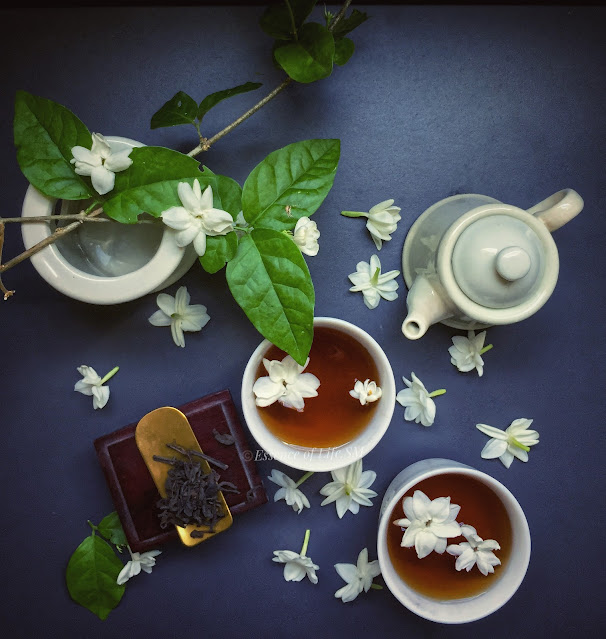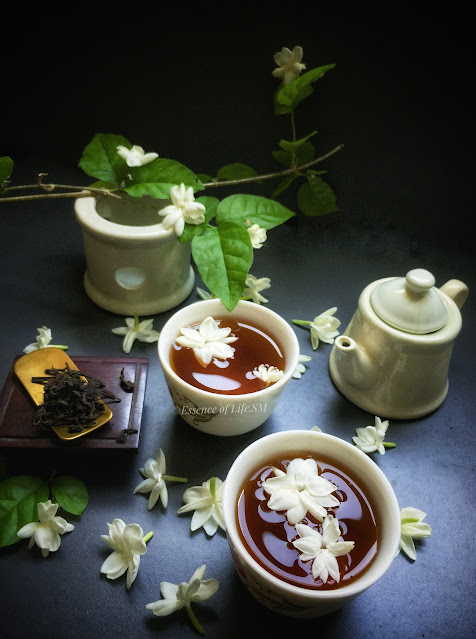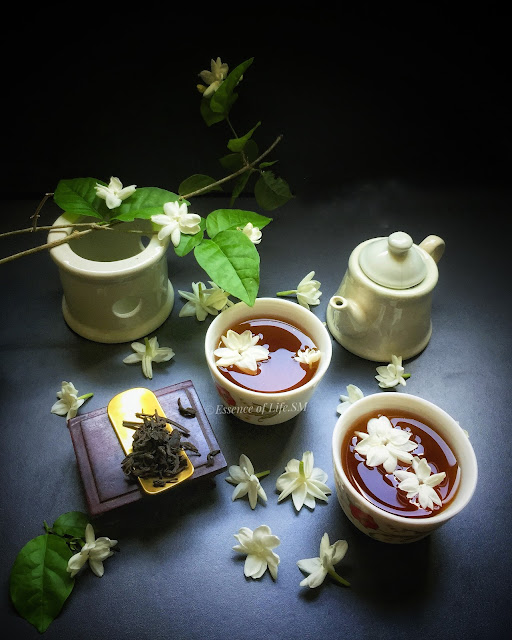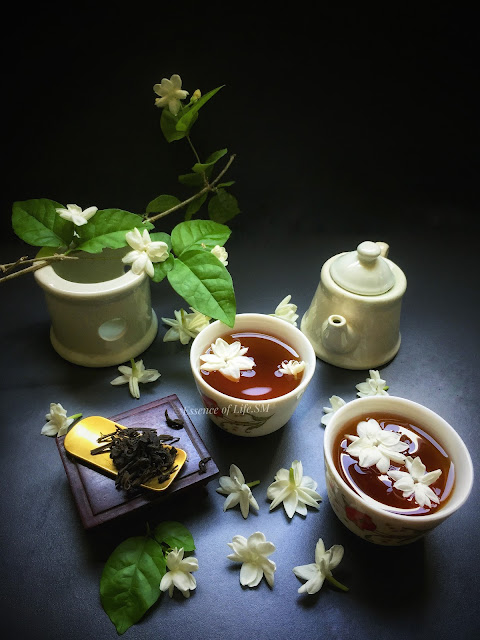HOW TO MAKE JASMINE TEA
What do I have to do with Chinese Tea? Living in Malaysia - a food haven with multicultural reflections, the region is open to Chinese Culture in its unique form. And here I got the chance of tasting Chinese Tea. While dining in Chinese Restaurants, they serve their unique tasting Chinese Teas. I was literally fancied by the Tea sets and the Tea making equipment that long back I collected a few items along with a huge Antique Dragon-Turtle Tea Pot big enough to brew Chinese Tea for a crowd.
Well, I am not a tea person, but still, I love to drink these
Chinese Teas when dining out in midst that I get heady to the drink(it makes me hyperactive). Especially, I love the Jasmine, Chrysanthemums & Rose
flavoured Chinese Teas prepared with dried flowers and Tea Leaves.
Mildly flavoured and rejuvenating to the senses. Jasmine tea is an exotically scented, sensually delicious, but a simple tea to make at home. Jasmine tea is one of the most famous teas in the world. Whether made
hot or cold, jasmine tea’s signature floral aroma makes it a great
choice to drink.
 |
| JASMINE |
Jasmine tea, one of the major types of flower tea
in China, is made by jasmine flowers and fresh tea leaves, so it has
both the aroma of jasmine flowers and the freshness of tea leaves. It is
welcomed by its strong fragrance, fresh flavour, tender and soft taste
and the rich benefits including preventing cancer, resist ageing,
relieving pain, and losing weight. Chinese jasmine tea was created
1,000 years ago in Fuzhou, Fujian, a southeast coastal province of
China.
What is Jasmine Tea?
 |
| HOW TO MAKE JASMINE TEA |
- Jasmine tea is a scented tea usually made from combining green tea leaves with jasmine petals.
- It has a delicate flavour and an exotic floral aroma.
- Sometimes made with white, oolong, or black tea.
- Jasmine tea is shaped into thin, rolled tea leaves or into balls (jasmine pearls).
How Jasmine Tea is scented:
 |
| JASMINE |
- Traditionally, this tea was scented by placing trays of fresh jasmine flowers below a woven tray of tea leaves in a warm room.
- Now, it’s common for the tea and flowers to be combined as the tea gets processed.
- High quality and more expensive jasmine tea is made with fresh jasmine flower buds.
- The more affordable and less expensive jasmine tea is made with jasmine extract.
- We can get it as Tea Leaves and Jasmine Buds mixed together.
- One best way is to steep the Tea Leaves along with fresh Jasmine flowers.
Which Jasmine Flower suits well for Jasmine Tea:
 |
| ARABIAN JASMINE |
When choosing the right “jasmine” to scent your tea, choose that specifically of the Jasminum species such as Jasminum officinale, Jasminum sambac, or Jasminum polyanthum. Fresh flowers serves best for the tea. I drop them directly onto a layer of tea in a large jar with a wide opening. This can be done indefinitely while jasmine is in bloom, layering the blossoms between layers of tea. What is usually sold in market/stores, especially in Chinese shops, are the dried Jasminum Sambac or the common Arabian Jasmine Buds. You can buy them and mix along with your favourite tea. Some Tea varieties are sold mixed along with these dried Jasmine Buds.
*NOTE: Do not use “star jasmine/confederate jasmine/jessamine” (Trachelospermum jasminoides) or “Carolina jessamine” (Gelsemium sempervirens) – which is toxic, not exotic.
HEALTH BENEFITS OF JASMINE TEA:
Prevents Cancer: Jasmine tea contains tea polyphenols and tea pigments, tea also contains selenium,
molybdenum, manganese, germanium etc. which can help in preventing
cancer caused by the insufficiency of manganese and redundancy of copper
in potable water. Jasmine green tea is believed to reduce risks of
breast cancer, lung cancer, and many other diseases.
Get rid of tiredness: Theine
in tea can stimulate the central nervous system and plays a vital role in getting rid of drowsiness, eliminating fatigue, enhancing vitality and
concentrating thinking.
HOW TO MAKE CHINESE JASMINE TEA
 |
| HOW TO MAKE JASMINE TEA |
Few basic knowledge of Tea Brewing, a decent quality Tea & a bit
of patience is all you need for a good Chinese Tea, any Tea as a matter
of fact. The best Tea in the world can taste horrible if prepared
incorrectly, but even an inexpensive Tea can be more satisfying if
prepared in the best possible way. So remember these 7 little facts
before brewing any type of Teas.
- The quality of the Tea
- The quality of the Water
- Correct measurement
- Correct steeping temperature
- Correct steeping time
- Allowing the tea-leaf to expand fully
- Separating the leaf from the liquid at the end of the steeping process
Use the best tea that is available to you. Scoop the loose tea leaves from the tea canister. Measure the correct amount of tea & add it into the Teapot. I have added fresh Jasmine flowers along with the tea leaves while brewing this Jasmine Tea.
WATER:
- When making any tea, try to use fresh & good quality water. Water quality reflects greatly on the taste of the Tea.
- Always start with fresh water out of the tap, not water that has been previously boiled or has been sitting around.
- First, use a small amount of heated water to warm the Tea Pot and Tea Cups before beginning to make your tea.
- To prepare the Chinese Tea, heat water in a kettle.
CORRECT MEASUREMENT:
The amount of Tea and Water will vary on the type of tea, its quality, and the size of the teapot, but generally, 1 Teaspoon of tea leaves for every six ounces/3/4 Cups of water will do.RIGHT WATER TEMPERATURE FOR TEA:
Raise the kettle to shoulder-length, and pour the hot Water into the Teapot over the tea leaves. The water should be poured just above the teapot to not remove the flavour from the tea leaves too quickly. After pouring the water, scoop away any excess bubbles or tea leaves. Place the lid on the teapot.
BREWING TIME:
The size of the tea leaves and their quality determine the length of the steeping time. A whole-leaf tea is steeped longer, and high-quality tea has a shorter brewing time.JASMINE TEA - WITH TEA LEAVES/TEA BAG:
ROOM FOR THE TEA LEAF TO EXPAND:
All teas require room for the leaf to expand greatly in size as it steeps. Make sure there is enough room for the leaf to expand up to 3-5 times in size.SEPARATING THE LEAVES & FLOWERS:
After the tea has steeped the proper length of time, separate the tea leaves & the jasmine flowers from the brewed Tea. Most teas will turn bitter if steeped too long.
 |
| HOW TO MAKE JASMINE TEA |
Enjoy The Pure Goodness of Chinese Jasmine Tea in an exotic way!!!
Wishing all my Chinese Friends a Happy Chinese New Year!
"Gong Xi Fa Chai"
_______________________________________________________________________
FOOD SAFETY:
Side Effects of Excessive Drinking
- Excessive drinking of Jasmine Tea will make you feel hungry, or even dizzy.
- It can be harmful to your intestines and prolong stomach digestion when you have it right after the meal.
- Jasmine Tea can cause calcium deficiency.
- It can cause endocrine disorder and menstrual disorder for female.









0 comments